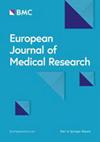通过新一代测序在 COVID-19 患者支气管肺泡灌洗液中鉴定出的真菌:一项回顾性研究
IF 2.8
3区 医学
Q2 MEDICINE, RESEARCH & EXPERIMENTAL
引用次数: 0
摘要
COVID-19 患者支气管肺泡灌洗液中通过新一代测序鉴定出的真菌的流行病学尚不清楚。分析中使用了去标识化信息,包括年龄、SARS-CoV-2 读数和支气管肺泡灌洗液中的真菌。共纳入了 960 名 COVID-19 患者。38名患者性别不明,其余648名患者(70.3%)为男性。有年龄信息的 876 名患者的平均年龄(标准)为 63.4 ± 21.3 岁,最小为 0.2 岁,最大为 101 岁。所有患者的 SARS-CoV-2 读数中位数[四分位数间距]为 26,038 [4421.5, 44,641.5]。在 159 例(16.6%)患者中发现了曲霉菌,其中烟曲霉、黄曲霉和黑曲霉分别为 103 例(10.7%)、81 例(8.4%)和 17 例(1.8%)。在 14 名(1.5%)患者中发现了黏菌科菌。在 65 名(6.8%)患者中发现了肺孢子菌,其中 12 名(18.5%)患者还发现了曲霉菌。在一些患者中还发现了隐球菌科和半知菌科细菌,其中 11 名患者(1.1%)携带隐球菌。通过新一代测序,在 COVID-19 患者的支气管肺泡灌洗液中,曲霉菌以及粘菌科、肺孢子菌属和隐球菌非常常见。本文章由计算机程序翻译,如有差异,请以英文原文为准。
Fungi identified via next-generation sequencing in bronchoalveolar lavage fluid among patients with COVID-19: a retrospective study
The epidemiology of fungi identified via next-generation sequencing in bronchoalveolar lavage fluid among patients with COVID-19 is unknown. De-identified information, including age, SARS-CoV-2 reads and fungi from bronchoalveolar lavage fluid, were used to analysis. A total of 960 patients with COVID-19 were included. Gender was unknown in 38 patients, and 648 (70.3%) of the rest patients were male. For 876 patients with information on age, their mean ± standard age was 63.4 ± 21.3 years, with the minimum being 0.2 years and the maximum being 101 years. For all the patients, their median [interquartile range] SARS-CoV-2 reads were 26,038 [4421.5, 44,641.5]. The Aspergilli were identified in 159 (16.6%) patients, with Aspergillus fumigatus, Aspergillus flavus and Aspergillus niger in 103 (10.7%), 81 (8.4%) and 17 (1.8%), respectively. The Mucoraceae were identified in 14 (1.5%) patients. Pneumocystis jirovecii was identified in 65 (6.8%) patients, among whom 12 (18.5%) patients also had Aspergilli. The Cryptococcaceae and the Dematiaceae were also identified in some patients, including Cryptococcus in 11 (1.1%) patients. In bronchoalveolar lavage fluid among patients with COVID-19, the Aspergilli were very commonly identified, as were the Mucoraceae, Pneumocystis jirovecii and Cryptococcus via next-generation sequencing.
求助全文
通过发布文献求助,成功后即可免费获取论文全文。
去求助
来源期刊

European Journal of Medical Research
医学-医学:研究与实验
CiteScore
3.20
自引率
0.00%
发文量
247
审稿时长
>12 weeks
期刊介绍:
European Journal of Medical Research publishes translational and clinical research of international interest across all medical disciplines, enabling clinicians and other researchers to learn about developments and innovations within these disciplines and across the boundaries between disciplines. The journal publishes high quality research and reviews and aims to ensure that the results of all well-conducted research are published, regardless of their outcome.
 求助内容:
求助内容: 应助结果提醒方式:
应助结果提醒方式:


